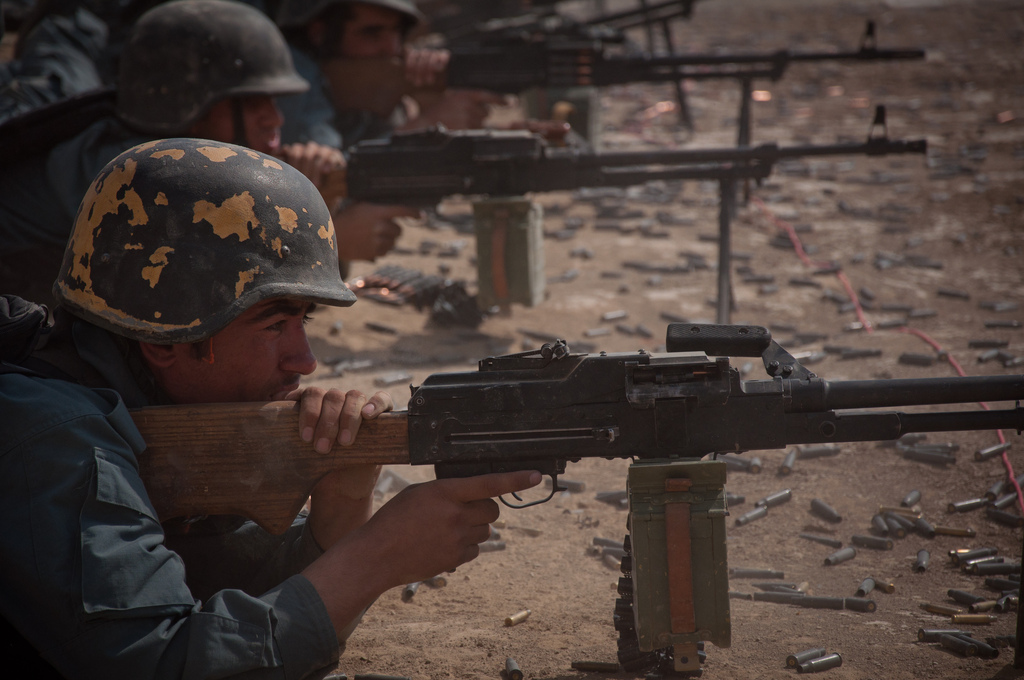F‑15K fighter jet pilots arriving at the First Fighter Wing to participate in the exercise. The drill of this year involves 60 warplanes. Provided by the Korean Air Force
 |
| F‑15K fighter jets stand by on the First Air Base in Gwangju on May 7. The combat aircraft currently participate in the first 2012 Max Thunder exercise, a ROK‑U.S. bilateral biannual large-scale air defense exercise conducted by the ROK Air Force Operations Command and the 7th U.S. Air Force. Provided by Korean Air Force Source: MND, Republic of Korea |
 |
| Here you can find more information about: |
Korean and U.S. Air Forces on May 7 launched their first largest-ever and longest-ever 2012 Max Thunder, a bilateral training exercise designed to demonstrate interoperability between ROK and U.S. air forces on the Korean Peninsula.
The joint exercise under the leadership of the Korean Air Force Operations Command will continue until May 8 and is being mobilized largely over the southwestern airspace of the Peninsula.
The exercise involves a total of 60 planes consisting of 38 from ROK Air Force including F‑15K fighters and 22 from the U.S. Air Force including an early warning and control system surveillance plane.
During the 12-day exercise period, based on a scenario replicating the initial stages of was, the combined air forces are expected to improve their air defense operations capabilities.
The operations are largely comprised of ‘air interdiction,’ an air operation conducted to disturb, delay, neutralize, or destroy enemy forces before they attack friendly ground and sea forces, and ‘defensive counter-air,’ another air core operation designed to detect, identify, intercept, and destroy or negate enemy forces attempting to attack or penetrate the friendly air environment.
This year’s Max Thunder marks the first time personnel from the Korean Army Special Forces Command participate in a bombing and a search and rescue drill to strengthen jointness between different branches of the armed forces.
The Command members is to infiltrate into the enemy’s deep area receiving supplies airdropped by friendly cargo planes to direct friendly fighters to, by delivering core target intelligence, accurately bomb the targets.
The Command personnel also are to sharpen a pilot survival exercise with seasoned survival instructors from both sides in a simulated war situation in which friendly pilots have been isolated in the enemy’s area because their planes had been shot down or engine trouble.
To avoid the enemy ships’ radar defense network, the Navy’s DDH2 or Type 3 destroyer will be deployed to play a role of a simulated enemy ship.
This year’s Max Thunder features an air refueling drill for the first time in the Max Thunder history during an air operation.
In particular, an air refueling instructor promotion drill was conducted at the same time the main air refueling drill, thus leading five pilots to become aerial refueling instructors.
Through this exercise, the ROK Air Force showed that it intended to hold ROK‑U.S strong combined air power to immediately counter any emergency on the Korean Peninsular through continuous two Air Forces’ joint exercise.
■ What is the Max Thunder exercise?
The Max Thunder exercise is a biannual major joint air exercise designed to demonstrate interoperability between the ROK and U.S. Air Forces on the Korean Peninsula. The exercise has become larger and larger in its scale since it began in 2008. Max Thunder is held in May and September every year.
The Max Thunder exercise is based on the U.S.-led multinational air exercise Red Flag conducted at Nellis Air Force Base, Nevada and Eielson Air Force Base, Alaska, USA.
Throughout this year’s exercise, the ROK and U.S. divide the participants into two parts, the Blue Air team and the Red Air team, to execute a real war-like warfare. The Blue team comprised personnel and aircraft from the allies and the Red one from the Korean Air Force’s training wing.
In the first half of the 12-day exercise period, the allied forces engaged in exercises designed to suppress the enemy’s air power as the enemy invaded the friendly forces’ airspace and to defend the friendly forces’ key targets.
In the second half, commanding air superiority in the enemy’s airspace and striking the enemy’s ground targets.
Source:
Ministry of National Defense[MND], Republic of Korea

 von
von 